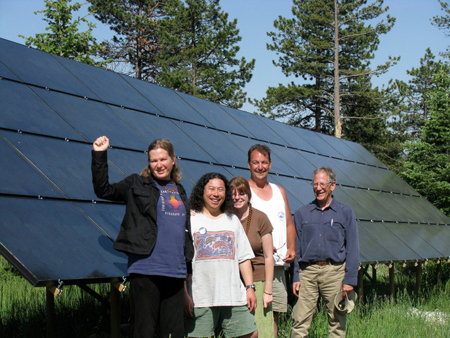By Colorado Energy News
Last week, the Board of the San Luis Valley town of Antonito, Colorado voted 7-0 to host a community owned “solar garden” at their water treatment site. Managed by Westminster-based Solar Panel Hosting Company, the half-acre, 50-kilowatt site will be sufficient to power 20 homes, and may be expanded up to 2000 kilowatts covering 16 acres if demand warrants.
Says Andrea Guajardo of Conejos County Clean Water, Inc., “I’m excited that we can move forward with sustainable economic development, it’ll provide a way for our community to educate itself about solar given the strong interest in both large scale and distributed solar in our area.”

Last Friday, the Lake County Commissioners voted 3-0 to approve a solar garden at a county-owned gravel pit near Leadville. The 50-kilowatt array could grow as large as 500 kilowatts, and supply subscribers in Lake, Chaffee, and Park counties including residents, businesses, nonprofits and county government.
Solar Panel Hosting CEO Joy Hughes said, “We now are assisting over a dozen Colorado projects, from Antonito, near the New Mexico border, up to Larimer county adjacent to Wyo. Most of the sites are on retired farmland, old mines or landfills.”
Not all the projects will be built the first year, said Hughes, “These will be small pilot projects in the beginning, but the gardens will grow. They will form a distributed power plant, a solar panel the size of Colorado.”
To promote renewable energy and energy efficiency, citizens in Saguache County, in southern Colorado have formed an organization called SAGE – Saguache Alliance for Green Energy. In April 2011, the Saguache town Board of Trustees signed a letter of intent with the Solar Panel Hosting Company to develop a solar garden located on one to two acres in the former town dump. Saguache’s 200-kilowatt system will power municipal buildings and residents whose roofs are shaded by the town’s many heritage trees.
City officials from Aurora toured two sites in Arapahoe and Adams counties. At 500 kilowatts apiece, these solar gardens together could supply enough power for hundreds of homes. “We support solar energy and opportunities to make it more accessible for all members of our community,” says Karen Hancock, Environmental Program Supervisor for the City of Aurora.
Other sites are located in Boulder, Weld and Jefferson counties. Nine solar gardens have applied to the Renewable Energy Development team at SRA international for technical assistance grants funded through the Governor’s Energy Office.
Solar Gardens Primer:
On June 5, 2010, former Governor Bill Ritter signed the Community Solar Gardens Act. A solar garden is a community owned solar array with at least 10 grid-connected “subscribers.” Each subscriber owns or leases a number of solar panels, and receives credit for the electricity the panels produce. Subscribers can be individuals, companies, schools, or municipalities – anyone with electric service from Xcel Energy or Black Hills Energy.Under the Act, the subscribers to a solar garden must reside within the same county or municipality. In counties with a population under 20,000, customers may subscribe to solar gardens in a neighboring county. Solar garden subscriptions are portable for subscribers who move within the same county. The minimum subscription size is one kilowatt, and a certain number of subscriptions must go to individuals who qualify for LEAP (Low-income Energy Assistance Program).
Some municipal and rural electric areas in Colorado offer their own separate community solar programs, including United Power, Holy Cross, Delta-Montrose Electric Area, Grand Valley Rural Electric, and Colorado Springs Utilities.
About the Solar Panel Hosting Company (SPH): The Solar Panel Hosting Company helps communities everywhere develop community solar arrays by working with local installers and nonprofits. SPH operates the website solargardens.org. SPH is a for-profit, for-benefit corporation exploring certified B corporation status.
![]() Editor’s Note: This news story comes to us as a cross post courtesy of Colorado Energy News. Author credit for the story goes to their staff.
Editor’s Note: This news story comes to us as a cross post courtesy of Colorado Energy News. Author credit for the story goes to their staff.